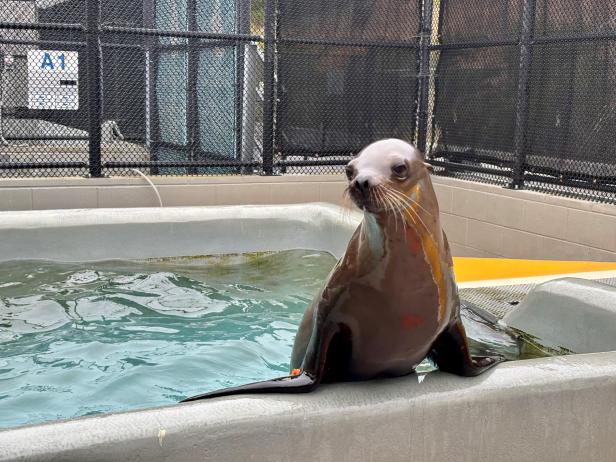 photo credit: Marine Mammal Center
photo credit: Marine Mammal CenterThe sub-adult female sea lion posing at a monitoring enclosure at the Marine
Mammal Center in Sausalito after being rescued July 5, 2025.
A sea lion capturing attention in Petaluma has moved out of the city, and not on it's own accord, following an unexpected rescue from the city's north end.
Despite the rescue, wildlife experts from Sausalito's Marine Mammal Center said they hope to see it released back into the wild soon.
The young sea lion first turned up on the banks of the Petaluma River on June 18, spotted on a floating dock at Steamer Landing Park.
Giancarlo Rulli, from the Marine Mammal Center in Sausalito, said, while it's not uncommon for sub-adult and juvenile sea lions to venture into freshwater like the Petaluma River, it's not as usual compared to other tributaries.
"For example, the Sacramento-San Joaquin River Delta system where transient California sea lions will stay for weeks on end as they pursue different easy prey, forage fish, like sea bass or things like carp," Rulli said.
Experts from the Marine Mammal Center, which operates the world's largest marine mammal hospital, tried a rescue in late June, but left the 3-5 year old female sea lion be, after it actively eluded them.
Rulli said on Saturday, July 5, "this juvenile female California sea lion exited the water near the premium outlets in Petaluma."
"The [Marine Mammal] Center received a call from our partners at North Bay Animal Services that the sea lion had made its way to the southern end of the mall's parking lot," Rulli said.
Rulli said the sea lion was safely captured, and is now in the Center's care, being monitored closely.
"It was very active and alert and it was also actively foraging offers of sustainably caught herring that our experts and volunteers were feeding it, which were all good signs," Rulli said.
Rulli said their vets will continue to check the sea lion's health, and look out for signs of poisoning from domoic acid, a naturally occurring shellfish toxin.
The Marine Mammal Center covers 600 miles of California Coast, and can treat as many as 1,800 marine mammals a year.
Rulli said when it comes to seeing distressed animals in unusual places, "the public is our eyes and ears in terms of calling our hotline, which is (415) 289-SEAL, where experts will ask a series of questions from the public reporting party and will likely send out an expert to perform an informed evaluation."
Rulli recommends the public keep a safe distance of 150 feet or more when near marine mammals like elephant seals, and he said the Center hopes to release the young sea lion back into the wild in Point Reyes National Seashore as soon as possible.

 Live Radio
Live Radio




